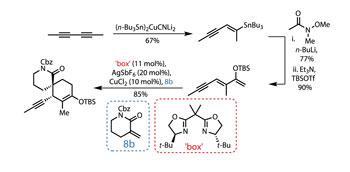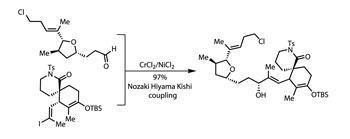(-)-Gymnodimine

I suspect there’s an element of the risk-taker in most organic chemists, and that can manifest in several ways. One is a lack of fear when working with ’excitable’ material, such as the classic sodium-mercury amalgam (worst of both worlds, there...), or oxygen-rich environments. Perhaps more so, though, is the total synthesis of scarily bioactive natural products. The targets from my DPhil, prostaglandins E2 and F2 α, were scary enough, as both are signalling agents in all of our bodies - but a former colleague handily one-ups me with the terrifying ’very fast death factor’, anatoxin A. Toxins of all sorts are actually very popular targets, and not just for kicks - they can make useful biological probes. Marine neurotoxins are a subset that are particularly handy, as their wont for disrupting human nervous systems has allowed deep insight into the workings of the brain.
An important subclass of marine neurotoxins contains spirocyclic imines. Larger examples such as the pinnatoxins have tended to hog the limelight, but the increasing prolific Daniel Romo of Texas A&M University, US, has focused his sights on gymnodimine - a slightly smaller family member.1 Smaller it may be, but the synthetic challenge is undimmed - a 16-membered macrocycle encompasses an azaspiro[5.5]undecadiene and a trisubstituted tetrahydrofuran.
The team’s approach was to firstly assemble the five-membered tetrahydrofuran ring. While somewhat pedestrian, the tried and tested aldol method they employed (originally developed by Clayton Heathcock2) reliably built a substantial chunk of the target, allowing the group to move onto the entirely more interesting spirocyclic part.

The plan for this complex fragment was to use a Diels-Alder reaction to construct the all-carbon cyclohexene, using a dienophile fragment containing the heterocyclic ring. After fashioning the necessary reactive diene from 2,4-hexadiyne, they coupled it with a relatively simple piperidinone (8b, figure 1) bearing an exocyclic alkene - a perfect recipe for a tasty Diels-Alder to set the spiro -ring junction. This venerable reaction was enhanced with a chiral copper bis-oxazoline (Cu-box) Lewis acid developed by David Evans,3 leading to excellent stereocontrol.
Dead ends and detours
With the two larger fragments complete, it was time for the group to firstly unite them, then close the macrocyclic ring. Unfortunately, I have to do the team an injustice here, as their 37 page pre-print paper details their mis-steps and ultimate success in rather compelling detail, which I can only summarise.

Their initial plan was to unite the fragments at the ’top’, using a Barbier reaction to metallate the alkyl chloride and attack the lactam ring; then close the macrocycle with the snappily titled NHK (Nozaki Hiyama Kishi) coupling of the aldehyde with the vinyl iodide. But the NHK was extremely recalcitrant, so the team used a common solution to this type of problem - they reversed the strategy. A successful NHK coupling (figure 2) and a few functional group transformations later, they were able to complete the 16-membered ring in reasonable yield, using their planned Barbier reaction (figure 3). Although all that has changed is the order of the steps, this sequence overturned their previous failure and returned an acceptable yield.

They weren’t quite home and dry, though, as they still had to add on a butenolide ring and close down the spirocyclic tetrahydropyridine. The first took a little coercion, again detailed in the paper, but the second was far less trouble, falling into place by simply freeing the pendant amine and allowing imine formation.
It’s really nice to see a chunky full paper describing a total synthesis campaign, as these reinforce the fact that the science is not easily predicted, and that there is still an element of art. If it’s been a while since you read this kind of magnum opus, can I suggest some bedtime reading material?
Paul Docherty is a science writer and blogger based in Reading, UK
References
- K Kong et al, J. Am. Chem. Soc., 2011, DOI: 10.1021/ja207385y
- H Danda, M M Hansen and C H Heathcock, J. Org. Chem., 1990, 55, 173 (DOI: 10.1021/jo00288a029)
- D A Evans et al, J. Am. Chem. Soc., 1999, 121, 7559 (DOI: 10.1021/ja991190k)












No comments yet